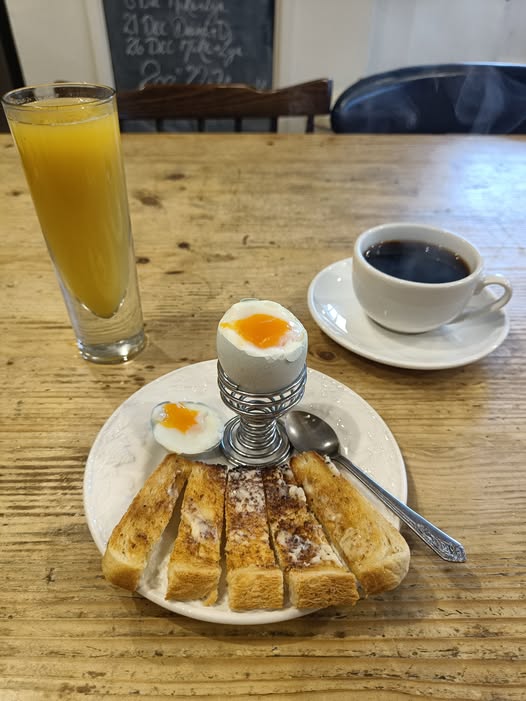Few breakfast rituals evoke as much nostalgia and comfort as the humble dippy egg. With its golden, runny yolk and tender white, this soft-boiled delight is more than just a meal—it’s a sensory experience. Paired with crisp toast soldiers and a warm beverage, the dippy egg has earned its place as a timeless staple across cultures.
📖 What Is a Dippy Egg?
A dippy egg is a soft-boiled egg cooked just long enough to set the whites while keeping the yolk luxuriously runny. Traditionally served in an egg cup, the top is sliced off to reveal the yolk, which is then “dipped into” using strips of toast—hence the name.
🔬 The Science Behind the Perfect Dippy Egg
Achieving the ideal texture requires precision:
- Egg size matters: Larger eggs need more time.
- Water temperature: Start with cold water and bring to a gentle boil.
- Timing is critical:
- Small eggs: 6–7 minutes
- Medium eggs: 7–8 minutes
- Large eggs: 8–9 minutes
Immediately after boiling, eggs should be placed in an ice bath to halt cooking and make peeling easier.
🍳 Cooking Techniques
There are two primary methods:
- Boiling: Place eggs in cold water, bring to a boil, then simmer.
- Steaming: Use a steamer basket over boiling water for gentler cooking.
Both methods yield excellent results when timed correctly.
🧂 Tips from Professional Chefs
- Use fresh eggs for better texture and flavor.
- Avoid cold eggs straight from the fridge—let them reach room temperature.
- Use a timer to avoid guesswork.
- Serve immediately with buttered toast soldiers, a sprinkle of salt, and optional herbs.
🥄 Serving Suggestions
- Classic: Toast soldiers and a pinch of sea salt.
- Gourmet: Add truffle oil, smoked paprika, or chive butter.
- Modern twist: Serve with avocado toast or sourdough fingers.
🧊 Storage and Safety
While dippy eggs are best enjoyed fresh, leftovers can be refrigerated and gently reheated. To ensure safety, cook until whites are fully set to reduce risk of bacteria like Salmonella
Few breakfast rituals evoke as much nostalgia and comfort as the humble dippy egg. With its golden, runny yolk and tender white, this soft-boiled delight is more than just a meal—it’s a sensory experience. Paired with crisp toast soldiers and a warm beverage, the dippy egg has earned its place as a timeless staple across cultures.
📖 What Is a Dippy Egg?
A dippy egg is a soft-boiled egg cooked just long enough to set the whites while keeping the yolk luxuriously runny. Traditionally served in an egg cup, the top is sliced off to reveal the yolk, which is then “dipped into” using strips of toast—hence the name.
🔬 The Science Behind the Perfect Dippy Egg
Achieving the ideal texture requires precision:
- Egg size matters: Larger eggs need more time.
- Water temperature: Start with cold water and bring to a gentle boil.
- Timing is critical:
- Small eggs: 6–7 minutes
- Medium eggs: 7–8 minutes
- Large eggs: 8–9 minutes
Immediately after boiling, eggs should be placed in an ice bath to halt cooking and make peeling easier.
🍳 Cooking Techniques
There are two primary methods:
- Boiling: Place eggs in cold water, bring to a boil, then simmer.
- Steaming: Use a steamer basket over boiling water for gentler cooking.
Both methods yield excellent results when timed correctly.
🧂 Tips from Professional Chefs
- Use fresh eggs for better texture and flavor.
- Avoid cold eggs straight from the fridge—let them reach room temperature.
- Use a timer to avoid guesswork.
- Serve immediately with buttered toast soldiers, a sprinkle of salt, and optional herbs.
🥄 Serving Suggestions
- Classic: Toast soldiers and a pinch of sea salt.
- Gourmet: Add truffle oil, smoked paprika, or chive butter.
- Modern twist: Serve with avocado toast or sourdough fingers.
🧊 Storage and Safety
While dippy eggs are best enjoyed fresh, leftovers can be refrigerated and gently reheated. To ensure safety, cook until whites are fully set to reduce risk of bacteria like Salmonella

